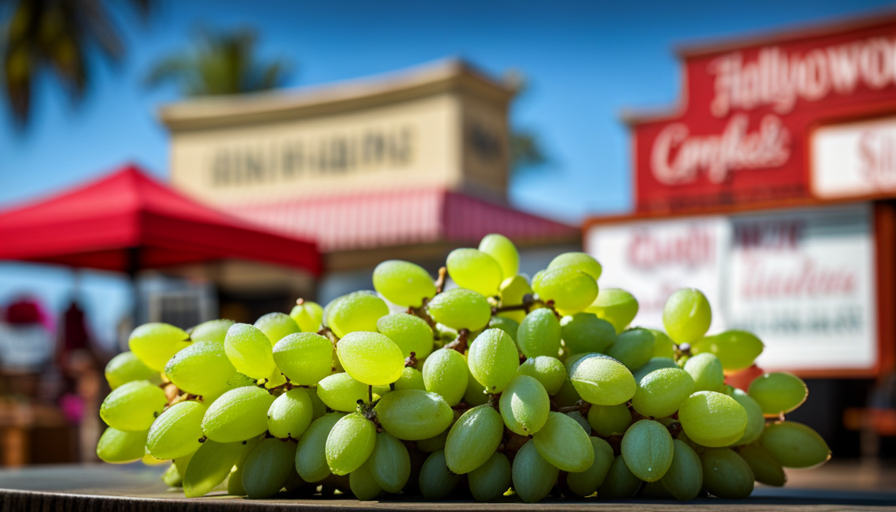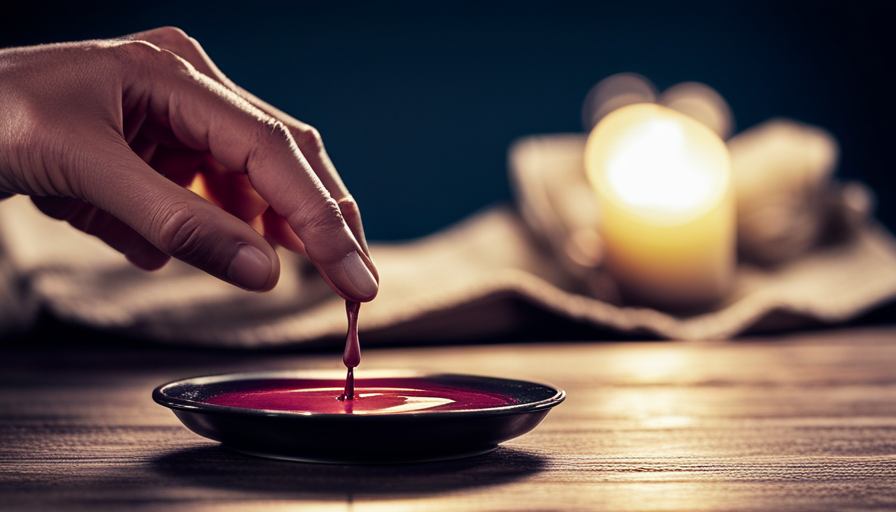Comparable to a secret passageway tucked away inside a candle, tunneling occurs when the flame creates a narrow tunnel down the middle, leaving the rest of the wax untouched. This can be frustrating for candle lovers, as it takes away from the aesthetic appeal and can impact the candle’s performance.
But fear not, for I am here to shed light on the mysterious phenomenon of candle tunneling. In this article, we will delve into the scientific intricacies of candle burning, exploring the various factors that contribute to this unwanted occurrence.
From uneven wax distribution to improper wick trimming, low-quality candles to drafts and airflow, we will uncover the root causes and present effective solutions.
So, gather around as we embark on a journey to decipher the secrets of candle tunneling and learn how to prevent it from casting a shadow on our candlelit moments.
Key Takeaways
- Candle tunneling is caused by factors such as uneven wax distribution, improper wick trimming, low-quality candles, drafts, and airflow.
- Paraffin wax, with its higher melting point, is more prone to tunneling.
- Proper wick maintenance and regular trimming, as well as burning the candle for a sufficient amount of time, can help prevent tunneling.
- Using candles with larger diameters and ensuring proper ventilation can also help prevent tunneling.
Understanding the Science of Candle Burning
You’re probably wondering why your candles always burn down the middle, leaving a hole in the center while the wax on the sides remains untouched. Well, let me explain the science behind this phenomenon.
Candle tunneling occurs due to a combination of factors, including candle burning experiments and the role of candle wax composition.
When a candle burns, the heat from the flame melts the wax near the wick. This liquid wax is then drawn up the wick and vaporizes, providing fuel for the flame. However, if the candle is not burned for a sufficient amount of time, the wax will only melt in the immediate vicinity of the flame. This creates a tunnel-like hole down the center of the candle, while the wax on the sides remains solid.
The composition of the candle wax also plays a role in tunneling. Some types of wax, such as paraffin, are more prone to tunneling than others. This is because paraffin wax has a higher melting point, making it harder for the heat from the flame to melt the outer edges of the candle evenly.
Understanding the science of candle burning and the role of candle wax composition is crucial in preventing tunneling and achieving an even wax distribution.
Now, let’s delve into the subsequent section about uneven wax distribution without delay.
Uneven Wax Distribution
To prevent uneven wax distribution, it’s important to ensure proper wick maintenance and regular trimming. This ensures that the heat from the flame is evenly distributed across the surface of the candle, allowing the wax to melt evenly. Here are three key factors to consider for achieving this:
-
Wick length: A wick that’s too long can cause the flame to burn too hot, resulting in uneven melting and tunneling. Trim the wick to about a quarter of an inch before each use to maintain a steady, controlled burn.
-
Burn time: Allowing the candle to burn for at least one hour per inch of its diameter helps avoid tunneling. This provides enough time for the wax to melt evenly across the entire surface, preventing a tunnel from forming.
-
Candle care: Properly caring for your candle can also contribute to even wax distribution. Keep the candle away from drafts, as they can cause uneven heat distribution. Additionally, avoid moving the candle while it’s burning, as this can disrupt the wax pool and lead to tunneling.
Now, let’s delve into the next section about improper wick trimming and its impact on candle burning.
Improper Wick Trimming
Improper wick trimming can spark a fiery rebellion within your candle, leading to a chaotic dance of flickering flames. This aspect of wick maintenance is often overlooked, but it plays a crucial role in ensuring a clean and even burn.
When a wick is not trimmed to the recommended length, it can cause the candle to tunnel. Tunneling refers to when the candle burns straight down the center, leaving a thick layer of unburned wax around the edges. This not only wastes valuable candle wax but also prevents the candle from reaching its full potential.
Proper wick trimming is an essential part of candle care. Before lighting your candle, it’s important to trim the wick to about 1/4 inch in length. This allows for a controlled and steady flame, ensuring that the wax is melted evenly and the candle burns efficiently. Regularly trimming the wick also helps to prevent the formation of soot and excess smoke, keeping the candle clean and free from any potential fire hazards.
Next, let’s delve into the issue of low-quality or improperly made candles, which can also contribute to candle tunneling.
Low-Quality or Improperly Made Candles
Using low-quality or improperly made candles can result in an uneven burn, leading to wasted wax and a diminished candle experience. When it comes to candle manufacturing, the quality of materials used plays a crucial role in ensuring a clean and even burn. Cheap or subpar materials may not burn properly, causing the wax to tunnel down the center of the candle and leaving a thick layer of unused wax on the sides. This not only reduces the overall burn time but also results in an inefficient use of the candle.
Additionally, low-quality wicks may not be properly sized or centered, further contributing to uneven burning. Inadequate candle manufacturing can also lead to other issues. Poorly made candles may have air pockets or gaps in the wax, which can cause the flame to flicker and burn unevenly. This can create an unsteady burn that contributes to tunneling. Furthermore, candles that are not properly tested or quality checked may have inconsistent formulas or fragrances, affecting their burn performance.
Transitioning into the next section about drafts and airflow, it’s important to understand how these factors can also impact candle burn.
Drafts and Airflow
Drafts and airflow can significantly affect the burn of a candle. Studies have shown that even a slight breeze can cause a candle flame to flicker up to 45 degrees off center. This can lead to uneven burning and the formation of candle tunnels.
To prevent this, it’s important to take measures to reduce drafts and ensure proper ventilation in the space where the candle is being burned. Reducing drafts is crucial for maintaining an even burn. This can be achieved by closing windows and doors, especially on windy days. It’s also helpful to place candles away from air vents and high-traffic areas where people frequently pass by. Additionally, using candle accessories such as shades or covers can create a barrier against drafts and promote a more consistent burn.
Ventilating spaces is equally important. Adequate airflow helps to prevent the formation of tunnels by ensuring that the heat is distributed evenly throughout the candle. Opening a window or using a fan can help in this regard, but it’s important to strike a balance to avoid excessive airflow, which can also cause issues with the burn.
In the subsequent section about burning candles for short periods of time, it’s essential to consider the impact of drafts and airflow on the overall burn. By taking steps to reduce drafts and properly ventilating the space, you can maximize the enjoyment and longevity of your candle.
Burning Candles for Short Periods of Time
To get the most out of your candle, try burning it for shorter periods of time. This is a simple yet effective way to avoid tunneling and prevent your candle from wasting wax. When a candle is burned for a short period of time, it allows the entire surface to melt evenly. This means that the next time you light your candle, it’ll burn evenly across the entire diameter, preventing tunneling.
Burning a candle for shorter periods of time also helps to maintain a consistent temperature throughout the wax. When a candle burns for too long, the outer edges of the wax can become cooler than the center, leading to uneven melting and tunneling. By burning the candle for shorter intervals, you can ensure that the wax melts uniformly and efficiently, avoiding any wasted wax and keeping the candle burning evenly.
Now that you know the benefits of burning candles for shorter periods of time, let’s move on to the next step: using candles with large diameters. By utilizing candles with larger diameters, you can further prevent tunneling and maximize the burn time of your candles.
Using Candles with Large Diameters
Opting for candles with larger diameters creates a mesmerizing display of warmth and light, while ensuring an even and long-lasting burn. When it comes to candle diameter considerations, there are a few key factors to keep in mind.
Firstly, a larger diameter allows for a larger pool of melted wax. This means that the flame has more fuel to burn, resulting in a more consistent and steady burn.
Secondly, a wider candle allows for better air circulation around the flame. This helps prevent the formation of a high temperature zone near the wick, which can cause uneven burning and tunneling.
Lastly, candles with larger diameters often have thicker wicks, which can help maintain a strong and steady flame.
To prevent candle tunneling, there are a few techniques you can try. Trim the wick to 1/4 inch before each use to ensure a clean and even burn. Also, make sure to let the candle burn for at least two hours during the first use to create a full melt pool. This helps prevent tunneling by melting the wax evenly across the entire surface.
Now, let’s move on to the next section about avoiding container candles.
Avoiding Container Candles
When you want to create a captivating and worry-free ambiance, container candles may not be your best choice. While container candles are popular and convenient, they’re more prone to tunneling compared to other types of candles. Tunneling occurs when the candle burns straight down the center, leaving unmelted wax along the sides. This happens because the heat isn’t distributed evenly, causing the wax to melt in a tunnel-like shape.
One reason why container candles are more susceptible to tunneling is the limited oxygen supply inside the container. The confined space restricts air circulation, making it difficult for the flame to burn efficiently. As a result, the wax closest to the wick melts faster, creating a tunnel and leaving untouched wax around the edges.
Furthermore, proper wick maintenance is crucial when using container candles. A well-trimmed wick promotes even burning and helps prevent tunneling. Trim the wick to about ¼ inch before lighting the candle and regularly check for any signs of mushrooming or soot buildup. Keeping the wick properly maintained ensures that the flame burns steadily and evenly, reducing the likelihood of tunneling.
To avoid the issues associated with container candles, consider using pillar or taper candles instead. These types of candles burn more evenly and are less prone to tunneling.
In the next section, we’ll discuss proper candle placement and burning techniques to further enhance your candle experience.
Proper Candle Placement and Burning Techniques
When it comes to avoiding candle tunneling, proper candle placement and burning techniques are essential. As a candle enthusiast, I’ve learned that taking the time to understand these techniques can greatly enhance both the safety and longevity of your candles.
Firstly, it’s crucial to always place your candles on a heat-resistant surface and away from any flammable materials. This simple candle safety precaution can prevent accidents and potential fire hazards.
Additionally, ensure that the candle is placed on a level surface to promote even burning and prevent uneven tunneling.
Furthermore, it’s important to choose the right type of scented candles to minimize the risk of tunneling. Opt for candles made with high-quality wax and lead-free wicks, which can significantly reduce the chances of tunneling occurring. Also, selecting candles with a wider diameter can help distribute the heat more evenly, avoiding the formation of tunnels.
By following these candle placement and burning techniques, you can enjoy a longer and more even burn, while also reducing the risk of accidents.
Now, let’s delve into troubleshooting and fixing candle tunneling issues, as there are steps we can take to address this concern and preserve the beauty of our candles.
Troubleshooting and Fixing Candle Tunneling Issues
To address the issue of tunneling, it’s important to troubleshoot and implement solutions that will help candles burn evenly and beautifully.
One of the troubleshooting techniques for preventing tunneling is to trim the wick before each burn. A long wick can cause the flame to burn too hot, leading to uneven melting and tunneling. By trimming the wick to about a quarter of an inch, you can ensure a more controlled and even burn.
Another technique is to burn the candle for a sufficient amount of time during each use. When a candle is only burned for a short period, it creates a small melt pool that doesn’t reach the edges of the container. This can create a tunneling effect, as the wax in the center remains untouched. To prevent this, allow the candle to burn long enough for the entire top layer of wax to melt and reach the edges.
Additionally, it’s important to place the candle in a draft-free area. Air currents can disrupt the flame and cause uneven burning. By placing the candle away from fans, open windows, or high-traffic areas, you can ensure a more consistent burn and minimize tunneling.
By implementing these troubleshooting techniques and following proper burning practices, you can prevent tunneling and enjoy a candle that burns evenly, creating a warm and inviting atmosphere in your space.
Frequently Asked Questions
Can candle tunneling be prevented by using a specific type of wax?
Using a specific type of wax can help prevent candle tunneling. Alternative candle waxes, such as soy or beeswax, have been found to provide better burn performance compared to traditional paraffin wax. Factors influencing candle tunneling include wick size, fragrance load, and container size. To combat tunneling, it’s important to choose a proper wick, avoid overloading the candle with fragrance, and ensure the container is wide enough for the wax to pool evenly.
How long should I burn a candle to avoid tunneling?
To avoid tunneling, it’s important to burn a candle for an adequate amount of time. Generally, it’s recommended to burn a candle for at least one hour for every inch in diameter. This allows the wax to melt evenly and prevents tunneling. Proper candle care also plays a role in preventing tunneling, such as trimming the wick to 1/4 inch before each use and keeping the candle away from drafts.
Is it safe to burn a candle in a drafty room?
In a drafty room, it may not be safe to burn a candle due to the impact of temperature on candle burning. The flickering flame can be easily extinguished by the air currents, resulting in an uneven burn.
Different types of drafts, like a window or a fan, can also cause the flame to flicker and dance, potentially leading to an increased risk of fire hazards. Therefore, it’s advisable to keep candles away from drafty areas to ensure safety.
Are there any specific candle holders that can help prevent tunneling?
Some candle holders can help prevent tunneling by allowing the wax to melt evenly. One alternative is a lantern-style holder with a chimney that directs the heat towards the sides of the jar, preventing uneven melting.
Another option is a candle warmer, which uses a gentle heat source to slowly melt the wax. These alternative methods for preventing tunneling can help maintain a consistent burn and extend the life of your candle.
Can I fix a candle that has already started tunneling?
Yes, you can fix a candle that has already started tunneling. To do so, you need to create a ‘burn memory’ by allowing the candle to burn long enough to melt the entire surface. This will prevent further tunneling and ensure an even burn in the future.
Additionally, if you have tunneling candles, you can repurpose them by melting the excess wax and using it to make new candles or wax melts.
Conclusion
In conclusion, the perplexing phenomenon of candle tunneling can be attributed to a multitude of factors. From uneven wax distribution to improper wick trimming, the science behind candle burning is truly a fascinating field.
It seems that low-quality or improperly made candles are also culprits in this conspiracy. And let’s not forget about those pesky drafts and airflow, always stirring up trouble.
If you want to avoid this waxy conundrum, steer clear of candles with large diameters and opt for non-container candles. Remember, proper candle placement and burning techniques are key to preventing tunneling.
So, light up your candles with caution and make sure to troubleshoot any tunneling issues that may arise.
Stay enlightened, my friends.









